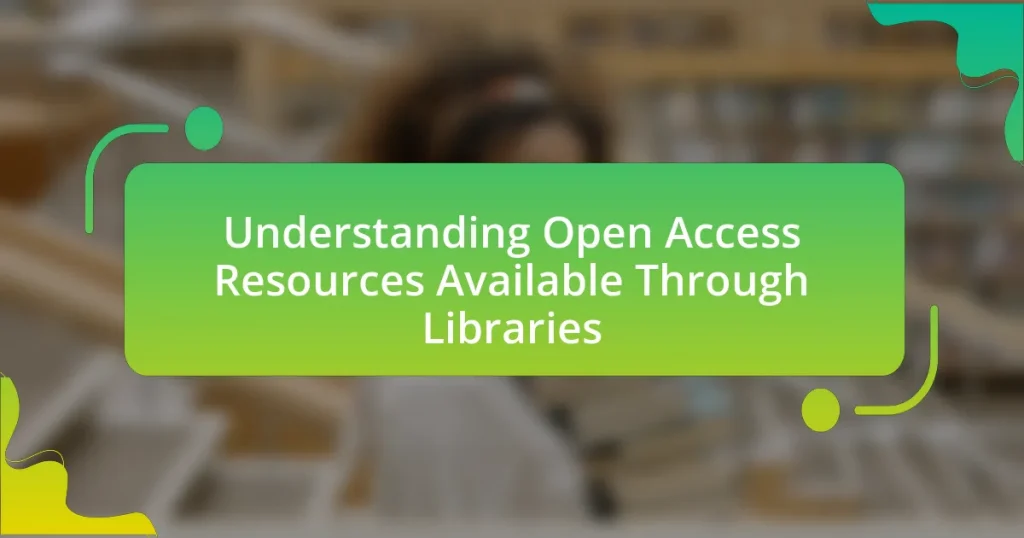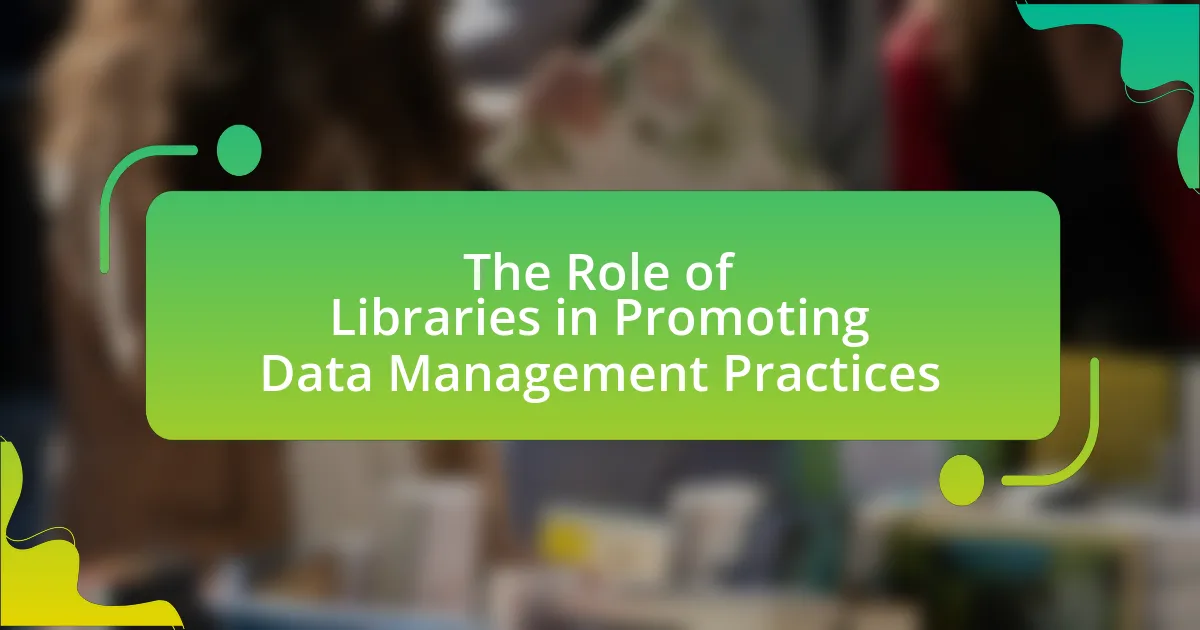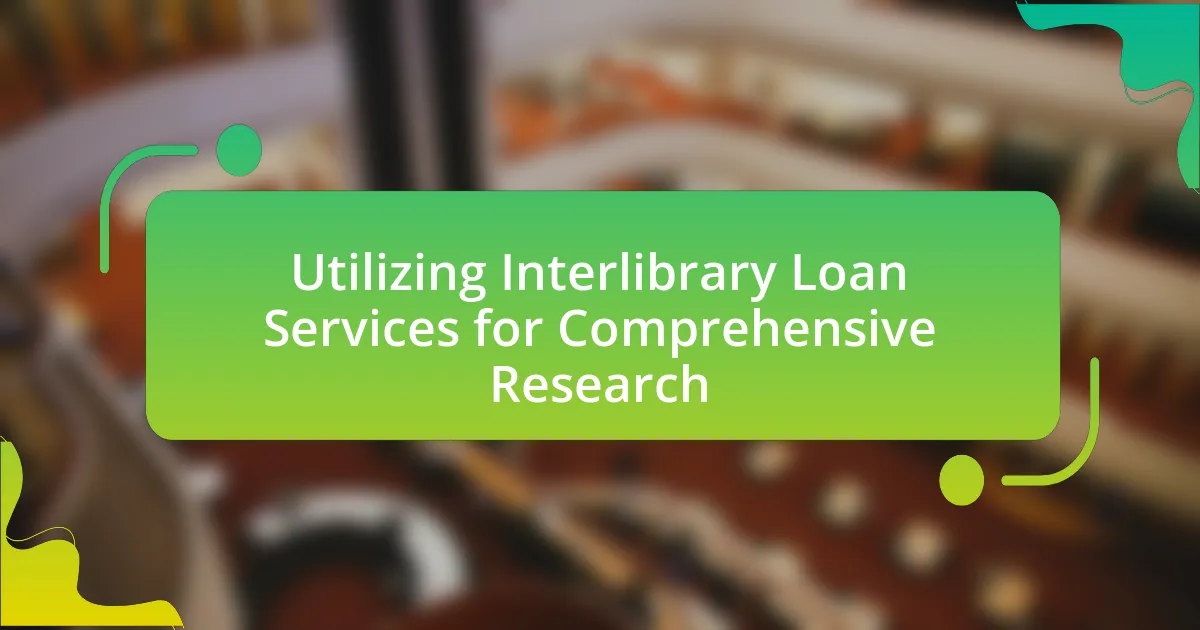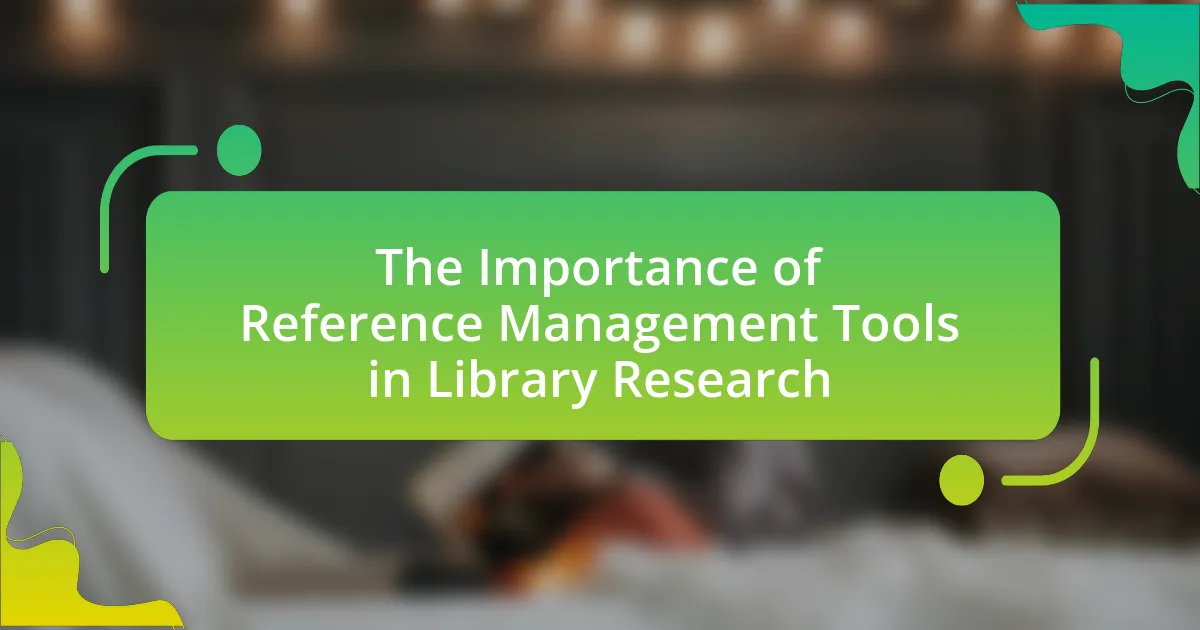Open Access Resources in libraries refer to digital materials that are freely accessible to the public, including scholarly articles, research papers, and educational materials, without subscription or payment barriers. This article explores the differences between Open Access and traditional resources, the types of materials included, and the importance of Open Access for academic research. It also discusses the principles of Open Access, the role of licenses, and the strategies libraries employ to promote these resources. Additionally, the article addresses the challenges libraries face in providing Open Access content and the benefits it offers to users, including enhanced research opportunities and collaboration among researchers. Finally, it highlights best practices for users to evaluate and utilize Open Access materials effectively.
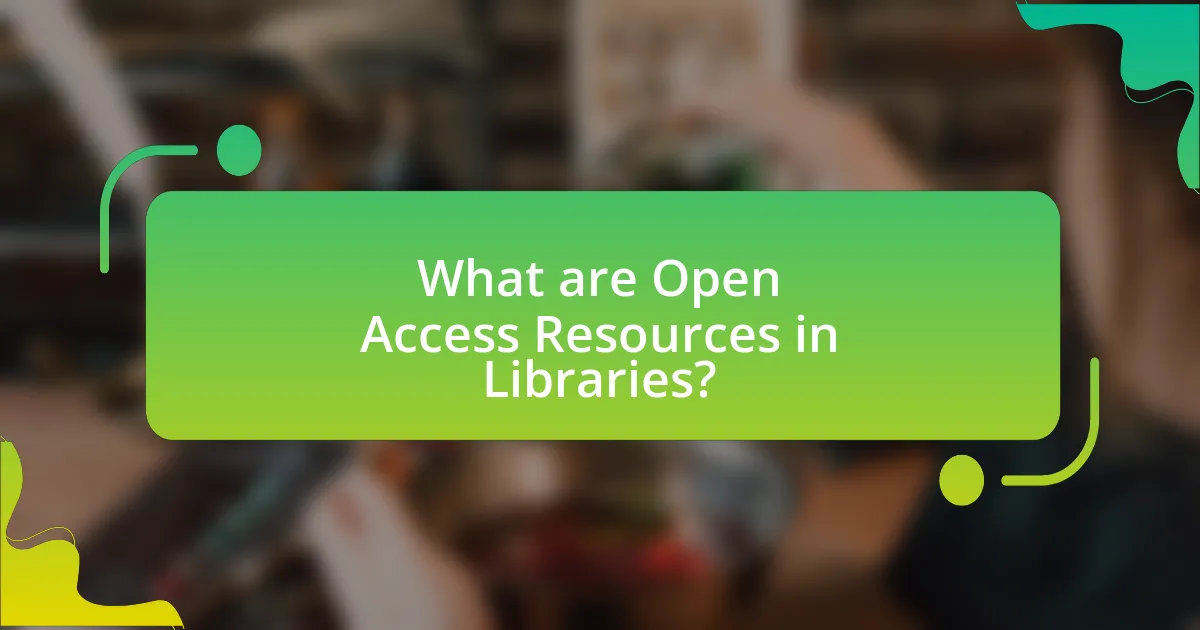
What are Open Access Resources in Libraries?
Open Access Resources in libraries are digital materials that are freely accessible to the public without subscription or payment barriers. These resources include scholarly articles, research papers, books, and educational materials that are made available under licenses permitting unrestricted use and distribution. The significance of Open Access Resources lies in their ability to enhance the dissemination of knowledge, as evidenced by the growth of platforms like PubMed Central and the Directory of Open Access Journals, which collectively host millions of freely accessible academic works.
How do Open Access Resources differ from traditional resources?
Open Access Resources differ from traditional resources primarily in their accessibility; Open Access Resources are freely available to the public without subscription or payment barriers, while traditional resources typically require a subscription or institutional access. This fundamental difference allows Open Access Resources to promote wider dissemination of knowledge and research, as evidenced by the growth of platforms like PubMed Central and arXiv, which provide free access to a vast array of academic articles and research papers. In contrast, traditional resources, such as journals published by major academic publishers, often restrict access to paying subscribers, limiting the reach and impact of the research.
What types of materials are included in Open Access Resources?
Open Access Resources include a variety of materials such as scholarly articles, research papers, theses, dissertations, books, and datasets. These resources are made freely available to the public, allowing unrestricted access to academic and research outputs. The Directory of Open Access Journals (DOAJ) lists over 16,000 peer-reviewed journals, demonstrating the extensive range of scholarly articles available. Additionally, platforms like arXiv and PubMed Central provide access to a vast array of research papers and datasets, further illustrating the diversity of materials included in Open Access Resources.
Why are Open Access Resources important for academic research?
Open Access Resources are important for academic research because they provide unrestricted access to scholarly information, enabling researchers to disseminate and share knowledge widely. This accessibility fosters collaboration and innovation, as studies show that open access articles are cited more frequently than those behind paywalls, with a 2016 study indicating that open access publications receive 18% more citations on average. Furthermore, open access resources enhance the visibility of research findings, allowing for greater public engagement and the potential for real-world impact.
What are the key principles of Open Access?
The key principles of Open Access are the unrestricted online access to scholarly research outputs and the free use and distribution of these works. Open Access promotes the idea that research funded by public money should be freely available to the public, enhancing the dissemination of knowledge. This principle is supported by the Budapest Open Access Initiative, which emphasizes that Open Access removes barriers to accessing research, thereby fostering greater collaboration and innovation in academia. Additionally, Open Access often involves the use of Creative Commons licenses, which allow authors to specify how their work can be used by others, ensuring that the research remains accessible while protecting the rights of the authors.
How does the concept of free access impact scholarly communication?
The concept of free access significantly enhances scholarly communication by removing financial barriers to research dissemination. This accessibility allows a broader audience, including researchers, students, and the general public, to engage with scholarly work, thereby increasing the visibility and impact of research findings. Studies indicate that articles published under open access models are cited more frequently than those behind paywalls, with a 2016 analysis showing that open access articles received 18% more citations on average. This increased citation rate fosters collaboration and knowledge sharing across disciplines, ultimately advancing scientific progress and innovation.
What role do licenses play in Open Access publishing?
Licenses play a crucial role in Open Access publishing by defining the terms under which published works can be accessed, shared, and reused. These licenses, such as Creative Commons, specify the rights granted to users, including whether they can modify the work, use it for commercial purposes, or require attribution to the original author. For instance, the Creative Commons Attribution license allows others to distribute, remix, adapt, and build upon a work, even commercially, as long as they credit the original creation. This framework not only facilitates broader dissemination of knowledge but also ensures that authors retain certain rights while promoting the free exchange of information.
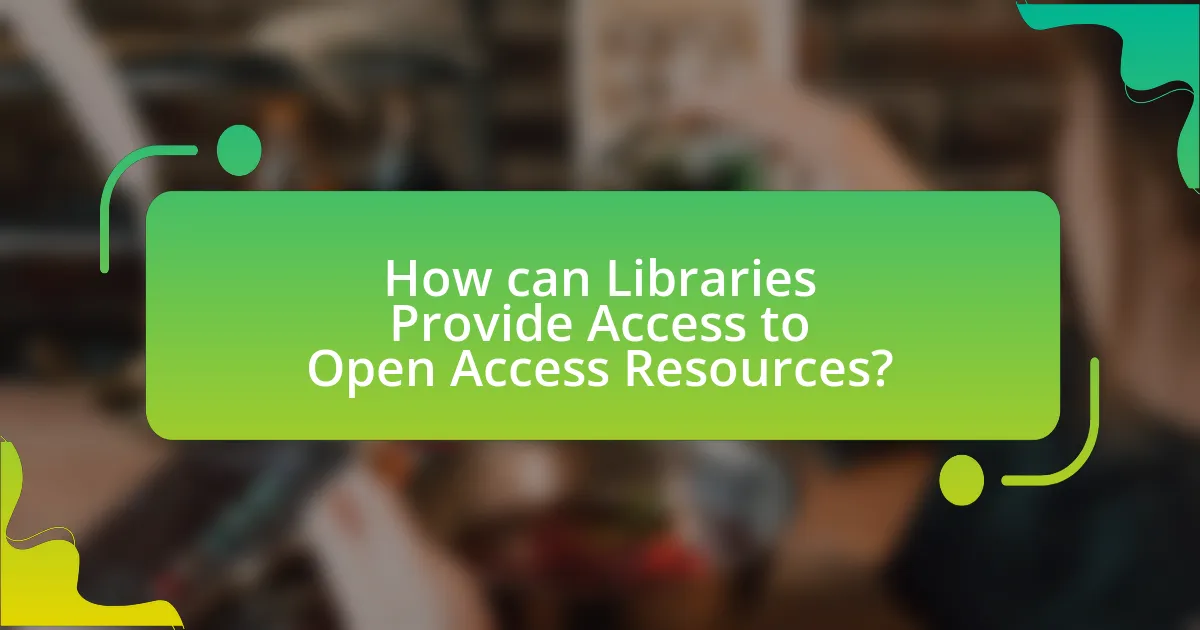
How can Libraries Provide Access to Open Access Resources?
Libraries can provide access to open access resources by curating and aggregating these materials in their collections, ensuring that users can easily find and utilize them. They achieve this by establishing partnerships with open access publishers and platforms, which allows libraries to offer a wide range of scholarly articles, journals, and educational resources without subscription fees. For instance, the Directory of Open Access Journals (DOAJ) lists thousands of peer-reviewed journals that libraries can promote to their patrons. Additionally, libraries often provide training and support to help users navigate these resources effectively, enhancing their ability to access and utilize open access content.
What strategies do libraries use to promote Open Access Resources?
Libraries employ various strategies to promote Open Access Resources, including educational outreach, integration into library catalogs, and partnerships with academic institutions. Educational outreach involves workshops and seminars aimed at informing users about the benefits and availability of Open Access materials. Integration into library catalogs ensures that Open Access resources are easily discoverable alongside traditional resources, enhancing visibility. Partnerships with academic institutions facilitate collaborative initiatives that encourage faculty and students to utilize and contribute to Open Access platforms. These strategies are supported by data indicating that libraries that actively promote Open Access see increased usage and engagement from their communities.
How do libraries educate users about Open Access?
Libraries educate users about Open Access by providing workshops, informational sessions, and online resources that explain the principles and benefits of Open Access publishing. These educational initiatives often include guidance on how to find and access Open Access materials, as well as discussions on copyright issues and the importance of freely available research. For instance, many academic libraries have developed specific guides and tutorials that detail how to navigate Open Access databases and repositories, ensuring users understand the value of these resources in enhancing research visibility and accessibility.
What partnerships do libraries form to enhance Open Access offerings?
Libraries form partnerships with academic institutions, publishers, and consortia to enhance Open Access offerings. These collaborations enable libraries to negotiate better access terms, share resources, and support the development of Open Access initiatives. For instance, partnerships with academic institutions often involve joint funding for Open Access publishing fees, while collaborations with publishers can lead to the establishment of transformative agreements that allow broader access to research outputs. Additionally, consortia partnerships facilitate collective bargaining power, enabling libraries to secure more favorable licensing agreements for Open Access content. These strategic alliances ultimately aim to increase the availability and visibility of scholarly works, thereby promoting wider dissemination of knowledge.
What challenges do libraries face in providing Open Access Resources?
Libraries face several challenges in providing Open Access resources, primarily related to funding, licensing, and technological infrastructure. Limited budgets restrict libraries’ ability to acquire and maintain Open Access materials, as many resources require ongoing financial support for hosting and distribution. Additionally, the complexity of licensing agreements can create barriers, as libraries must navigate various terms and conditions that may limit access or usage rights. Furthermore, inadequate technological infrastructure can hinder the effective delivery of Open Access resources, as libraries may lack the necessary systems to support seamless access for users. These challenges collectively impact the ability of libraries to fully realize the potential of Open Access resources for their communities.
How do funding models affect the availability of Open Access Resources?
Funding models significantly influence the availability of Open Access resources by determining the financial support for publishing and maintaining these resources. For instance, models that rely on institutional funding or article processing charges (APCs) can limit access based on the financial capabilities of institutions or authors, thereby affecting the overall volume of Open Access materials available. According to a study by the European Commission, institutions with dedicated funding for Open Access publishing saw a 50% increase in the number of articles published in Open Access compared to those without such funding. This demonstrates that robust funding models can enhance the accessibility and diversity of Open Access resources, while inadequate funding can restrict their availability.
What technological barriers exist for libraries in accessing Open Access content?
Libraries face several technological barriers in accessing Open Access content, primarily including inadequate infrastructure, lack of interoperability, and insufficient digital literacy among staff. Inadequate infrastructure refers to outdated hardware and software systems that hinder efficient access to digital resources. Lack of interoperability arises when different platforms and systems do not communicate effectively, making it difficult for libraries to aggregate and access diverse Open Access materials. Insufficient digital literacy among library staff can impede the effective use of available technologies and resources, limiting their ability to navigate and utilize Open Access content efficiently. These barriers collectively restrict libraries from fully leveraging the benefits of Open Access resources.
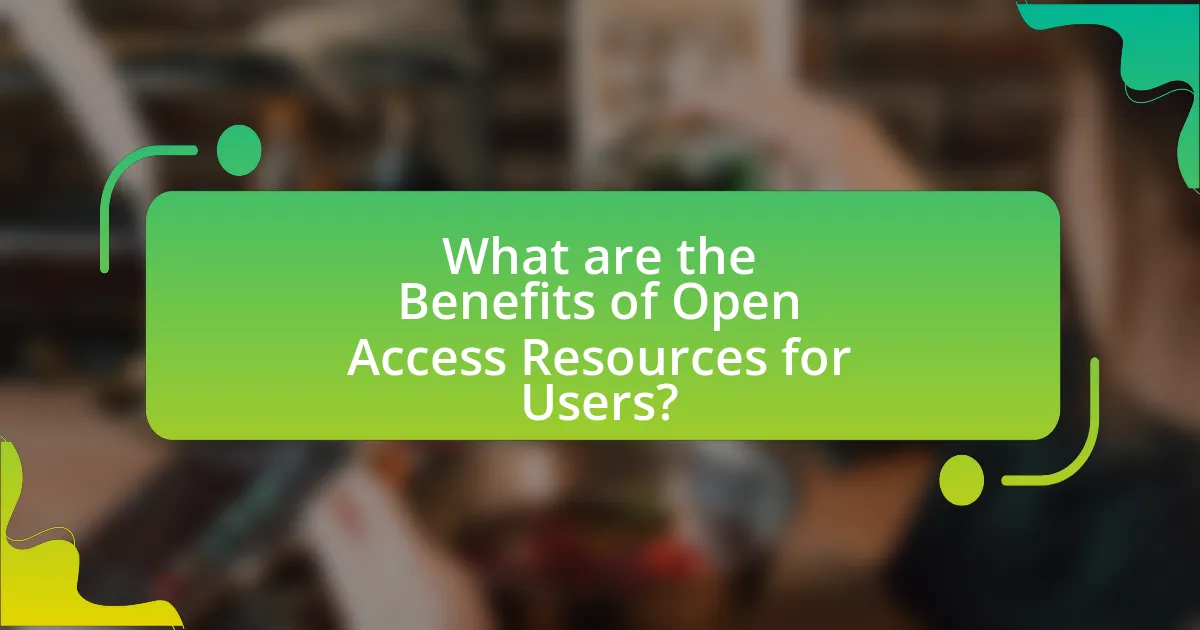
What are the Benefits of Open Access Resources for Users?
Open access resources provide users with free and unrestricted access to scholarly content, enhancing research and learning opportunities. These resources eliminate financial barriers, allowing users from diverse backgrounds, including students and researchers, to access high-quality academic materials without subscription fees. According to a study published in the journal “PLOS ONE,” open access articles receive 18% more citations than their subscription-based counterparts, indicating that wider accessibility leads to increased visibility and impact of research. Additionally, open access fosters collaboration and knowledge sharing among researchers globally, promoting innovation and accelerating scientific progress.
How do Open Access Resources enhance research opportunities?
Open Access Resources enhance research opportunities by providing unrestricted access to scholarly articles, data, and educational materials. This accessibility allows researchers, regardless of their institutional affiliation or financial resources, to engage with the latest findings and contribute to their fields. According to a study published in the journal PLOS ONE, open access articles receive 18% more citations on average than those behind paywalls, indicating that wider availability leads to increased visibility and collaboration among researchers. Furthermore, Open Access Resources facilitate interdisciplinary research by breaking down barriers between disciplines, enabling a more comprehensive approach to problem-solving and innovation.
What impact do Open Access Resources have on collaboration among researchers?
Open Access Resources significantly enhance collaboration among researchers by providing unrestricted access to scholarly articles and data. This accessibility fosters a more inclusive research environment, allowing researchers from diverse institutions and backgrounds to share findings and methodologies without financial barriers. A study published in the journal “PLOS ONE” found that Open Access articles are cited more frequently than subscription-based articles, indicating that wider dissemination leads to increased visibility and collaboration opportunities. Furthermore, platforms like PubMed Central and arXiv facilitate networking and partnerships by enabling researchers to discover and connect with others working on similar topics, thus driving collaborative efforts in various fields.
How do Open Access Resources support diverse learning needs?
Open Access Resources support diverse learning needs by providing free and unrestricted access to a wide range of educational materials, enabling learners from various backgrounds to engage with content that suits their individual learning styles and requirements. These resources include academic journals, textbooks, and multimedia content, which cater to different levels of understanding and areas of interest. Research indicates that Open Access initiatives can enhance educational equity; for instance, a study by the European Commission found that Open Access can significantly improve access to knowledge for underrepresented groups, thereby fostering inclusivity in education.
What are the potential drawbacks of Open Access Resources?
The potential drawbacks of Open Access Resources include concerns about quality control, financial sustainability, and the potential for information overload. Quality control issues arise because not all Open Access publications undergo rigorous peer review, which can lead to the dissemination of subpar research. Financial sustainability is a challenge, as many Open Access models rely on article processing charges that can limit access for authors from low-income institutions or countries. Additionally, the vast amount of freely available information can overwhelm users, making it difficult to discern credible sources from unreliable ones. These drawbacks highlight the complexities associated with Open Access Resources in the context of library services.
How can the quality of Open Access materials vary?
The quality of Open Access materials can vary significantly due to factors such as the rigor of the peer review process, the reputation of the publishing platform, and the expertise of the authors. For instance, some Open Access journals employ stringent peer review standards similar to traditional journals, ensuring high-quality research, while others may lack thorough review processes, leading to lower quality content. A study by the Directory of Open Access Journals (DOAJ) indicates that journals indexed in their database adhere to specific quality criteria, which can serve as a benchmark for assessing the reliability of Open Access materials. Additionally, the credibility of the authors and their affiliations can also impact the perceived quality, as established researchers typically produce more reliable and impactful work.
What are the implications of predatory publishing in Open Access?
Predatory publishing in Open Access undermines the credibility of scholarly communication by prioritizing profit over quality. This practice leads to the dissemination of low-quality research, which can misinform the academic community and the public. A study by Beall (2016) identified over 1,000 predatory journals that exploit authors by charging publication fees without providing legitimate editorial services. Consequently, researchers may struggle to distinguish reputable journals from predatory ones, which can damage their professional reputation and hinder academic progress. Furthermore, the proliferation of predatory journals can dilute the overall quality of scientific literature, making it challenging for libraries and institutions to curate reliable resources for their users.
What best practices should users follow when utilizing Open Access Resources?
Users should follow several best practices when utilizing Open Access Resources to maximize their effectiveness and ensure proper usage. First, users should verify the credibility of the Open Access journals or platforms they are accessing, as not all Open Access resources maintain rigorous peer-review standards. According to a study published in the journal “PLOS ONE,” approximately 30% of Open Access journals do not adhere to established academic publishing standards, which can lead to the dissemination of unreliable information.
Second, users should familiarize themselves with the licensing agreements associated with Open Access materials, as these agreements dictate how the content can be used, shared, or modified. For instance, resources under Creative Commons licenses allow varying degrees of reuse, which users must understand to comply with copyright laws.
Third, users should utilize library resources and tools that aggregate Open Access content, such as institutional repositories or databases like DOAJ (Directory of Open Access Journals), to ensure they are accessing high-quality materials. Research indicates that using curated databases can significantly enhance the discovery of reputable Open Access literature.
Lastly, users should engage with the academic community by citing Open Access resources appropriately in their work, as this practice not only gives credit to the original authors but also promotes the visibility of Open Access scholarship. Following these best practices will enhance the user experience and contribute to the integrity of academic research.
How can users effectively evaluate the credibility of Open Access materials?
Users can effectively evaluate the credibility of Open Access materials by assessing the author’s qualifications, the publication’s peer-review status, and the presence of citations. Evaluating the author’s qualifications involves checking their academic background and affiliations to ensure they are experts in the field. The peer-review status indicates that the material has undergone scrutiny by other experts, which enhances its reliability. Additionally, credible Open Access materials typically include citations from reputable sources, demonstrating that the information is supported by existing research. These criteria help users discern the quality and trustworthiness of the materials they encounter.
What tools can assist users in finding reliable Open Access Resources?
Tools that assist users in finding reliable Open Access Resources include databases like Directory of Open Access Journals (DOAJ), Open Access Button, and Unpaywall. DOAJ provides a comprehensive directory of peer-reviewed open access journals, ensuring users access quality research. Open Access Button allows users to find free, legal copies of research articles, while Unpaywall offers a browser extension that helps locate open access versions of paywalled articles. These tools enhance the accessibility and reliability of scholarly information in the open access landscape.
